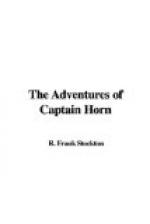“And how much money would be needed?” asked the other.
“That remains to be calculated,” replied Cardatas. Then the two went to work to calculate, and spent an hour or two at it.
When they parted, Nunez had not made up his mind that the plan of Cardatas was a good one, but he told him to go ahead and see what could be done about getting the Arato and a reliable crew, and that he would talk further to him about the matter.
That night Nunez took a train for Santiago, and on his arrival there, the next morning, he went straight to the shop of the jeweller of whom had been obtained the piece of gold in his possession. Here he made some cautious inquiries, and found the jeweller very ready to talk about the piece of gold that Nunez showed him. The jeweller said that he had had four pieces of the gold in his possession, and that he had bought them in Lima to use in his business. They had originally come from California, and were very fine gold. He had been a little curious about it on account of the shape of the pieces, and had been told that they had been brought into the country by an American sea-captain, who had seemed to have a good many of them. The jeweller thought it very likely that these pieces of gold passed for currency in California, for he had heard that at one time the people there had had to make their own currency, and that they often paid for merchandise in so many penny-weights and ounces of gold instead of using coin. The jeweller was himself very glad to do business in this way, for he liked the feel of a lump of gold.
After explaining that his reason for making these inquiries was his fear that the piece of gold he had accepted in trade because he also liked the feel of lumps of gold, might not be worth what he had given for it, Nunez thanked the jeweller, left him, and returned to Valparaiso. He went straight to his friend Cardatas, and said that he would furnish the capital to fit out the Arato for the projected trip.
It was not in twenty-four hours, but in forty-eight, that the schooner Arato cleared from Valparaiso for Callao in ballast. She had a good set of sails, and a crew of ten men besides the captain. She also had on board a passenger, Nunez by name, and a tall negro, who doubtless could turn his hand to some sort of work on board, and whom it would have been very indiscreet to leave behind.
Once outside the harbor, the Arato changed her mind about going to Callao, and sailed southward.
CHAPTER XXXVIII
THE COAST OF PATAGONIA
For about ten days after the brig Miranda left Valparaiso she had good winds and fair weather, and her progress was satisfactory to all on board, but at the end of that time she entered upon a season of head winds and bad weather. The vessel behaved very well in the stormy days that followed, but she made very little headway. Her course was now laid toward the Gulf of Penas, after reaching which she would sail along the protected waterways between the chain of islands which lie along the coast and the mainland, and which lead into the Straits of Magellan.




